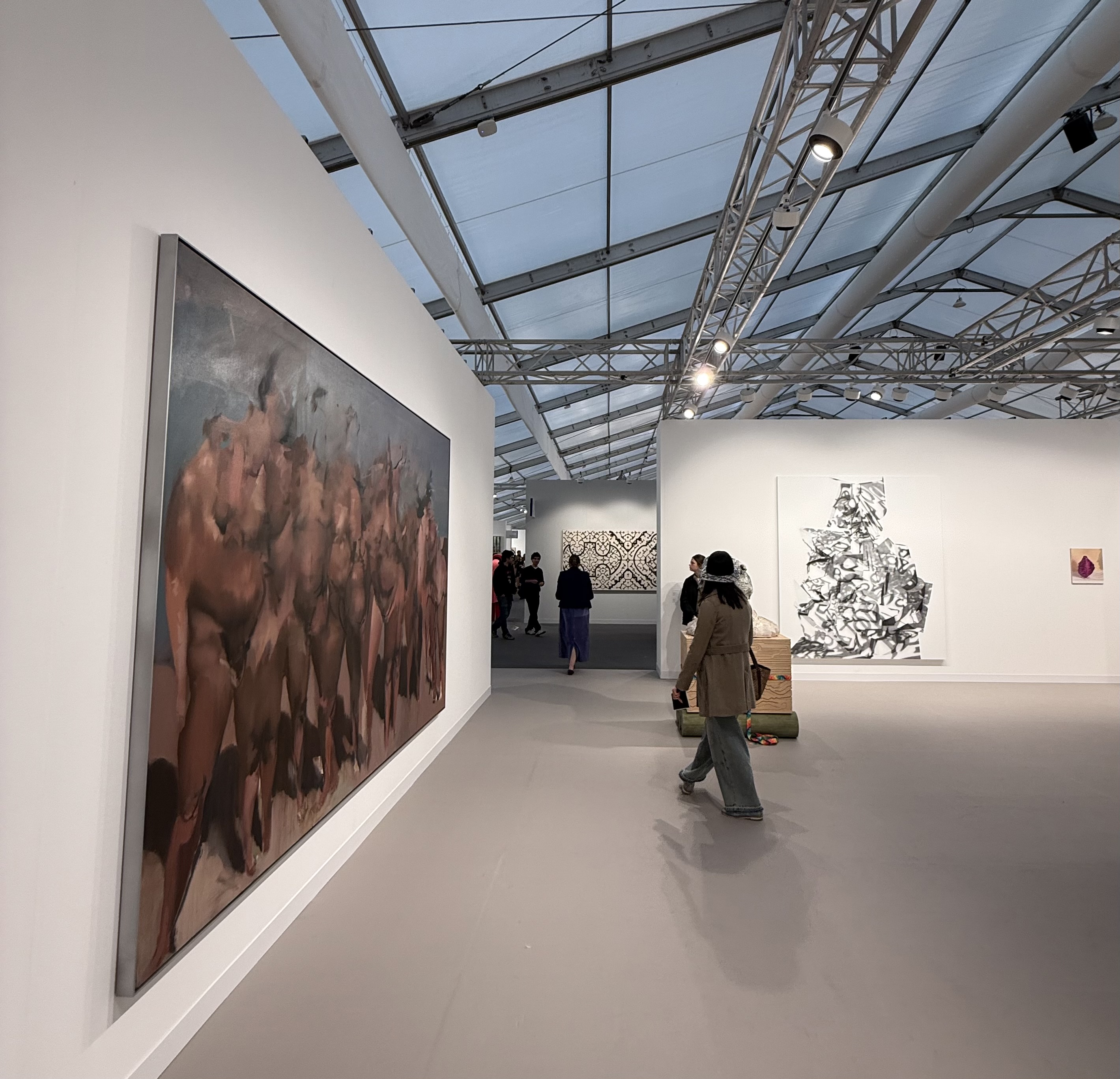When giants falter: What really happens when the gallery model breaks
When Hauser & Wirth’s UK accounts were filed on 24 September 2025, they did more than raise eyebrows. They showed how even the best-run galleries can struggle when the market cools. According to The Financial Times, the filing showed revenues falling from £144 million to £68 million and pre-tax profit collapsing by around 90%, from £9.3 million to £1.2 million, as secondary-market activity decelerated sharply.¹
These aren’t insolvency figures; they are liquidity figures. They show how fast profitability can disappear when high-end deal flow weakens, even for galleries operating at the top of the market.
Hauser & Wirth isn’t alone. PRAZZLE reported that David Zwirner’s UK subsidiary faced an almost identical contraction, with pre-tax profits down 89% to £1.1 million, compared with £9.9 million in 2022, and revenue sliding from £186 million to £130 million.² Both filings cited softening global demand and fewer seven-figure transactions.
Together, these results show that even the most powerful galleries, structured, diversified, and globally distributed, are not immune to the same 90% profit compression. It’s not coincidence; it’s the arithmetic of the gallery model itself.
While Hauser & Wirth’s 2025 UK accounts reflected a sharp contraction, the gallery is already looking ahead, with a new space slated to open in 2027. Far from contradicting the data, this underscores the point: even at the highest tier, galleries must manage liquidity carefully through market cycles to fund growth without eroding stability. Strategic finance isn’t a crisis tool but a mechanism for sustaining long-term investment through short-term volatility.
The question, then, is what actually breaks when revenue collapses and whether structured finance can change the outcome.

Hauser & Wirth booth at Frieze London, 2025. Photo: © Rhea Mathur
The fixed-cost trap: why scale doesn’t equal stability
Whether you are a Mayfair townhouse gallery or a global operation with spaces in Los Angeles, New York and Hong Kong, the equation doesn’t change. Rent isn’t flexible, payroll can’t be paused, and storage, insurance, shipping, and art-fair commitments all recur regardless of turnover. Revenue, by contrast, arrives in bursts, during fair cycles, in seasonal sales windows, and through sporadic secondary-market deals.
When transaction velocity slows, cash inflow dries up almost immediately while costs keep running.
Hauser & Wirth’s UK performance makes this arithmetic clear. As revenue halved, profit fell nearly in step - a classic sign of high operating leverage, where expenses are fixed but income fluctuates.The same filings for David Zwirner’s UK operation show a similar pattern: despite global reach and a blue-chip roster, the gallery’s UK profit margin narrowed sharply year-on-year.²
This is a structural issue, not a managerial one. Galleries are built for expansion, not contraction.
Even Marlborough Gallery’s 2024 closure, reported by The Guardian and The Art Newspaper after nearly 80 years in business, reflected the same logic on a longer timeline. Turnover in its London arm declined by 35%, and legal costs reached US $18.7 million, pushing overhead beyond sustainability.³ ⁴ The names change, but the arithmetic doesn’t.
Strategic finance: what could have changed the equation?
The conversation is not about selling more art but about buying time. Structured finance cannot fix demand cycles, but it does correct timing mismatches between when a gallery pays its bills and when it actually gets paid.
Inventory-backed revolving credit
Both Hauser & Wirth and Zwirner hold significant owned inventory with clear title and reliable secondary-market liquidity. Lenders such as Sotheby’s Financial Services or major private banks typically advance up to 50% of a work’s low auction estimate, using those figures as a conservative baseline for credit.⁵ Yet auction estimates are often strategically calibrated, set low to stimulate bidding or high to flatter consignors, which means they rarely represent a stable or objective lending value. On top of that, most lenders require the artworks to be moved into third-party custody. That structure protects the lender but disrupts the gallery’s ability to use the work as active inventory, effectively taking it out of circulation.
Artscapy Finance approaches the same problem from the opposite direction - not by locking collateral away, but by keeping it active. It structures credit around how galleries truly function. Advances of up to 70% are made against Artscapy’s own in-house valuation, determined using live market comparables rather than auction proxies that can distort pricing, and supported by Artscapy’s proprietary rating methodology. Works can remain under the gallery’s control for inventory and exhibition purposes, provided they are properly insured and recorded.
This alignment between liquidity and inventory allows galleries to continue showing, consigning, or even selling pledged works without interrupting credit lines, so long as replacement collateral or repayment occurs within agreed parameters. In practice, the facility supports the rhythm of the gallery business instead of freezing it. Used proactively, this type of revolving credit turns balance-sheet assets into working capital, a buffer that absorbs revenue shocks without forcing discounted sales.
Receivables finance for extended payment terms
Museums and collectors increasingly buy on six- to 24-month payment schedules, effectively turning galleries into interest-free lenders. Receivables facilities advance 70–80 % of invoice value for verified contracts with creditworthy buyers and are repaid when payments clear.⁶ This converts slow cash into fast cash, smoothing payroll and rent cycles without touching inventory.
VAT and cross-border logistics bridges
International galleries often pre-pay five percent import VAT or post equivalent security under Temporary Admission schemes.⁷ For galleries shipping multiple works to events like Frieze or Basel, that’s six-figure capital trapped in transit. Short-term VAT bridges free that liquidity exactly when expenses peak.
Pricing integrity and market stability
When galleries discount to raise cash, they don’t just lose margin, they reset the market. Once a sale falls below benchmark prices, that figure becomes the new comparable. Access to credit gives galleries the time to wait for the right buyer at the right price, preserving both artist markets and long-term credibility.
What finance cannot fix
Financial tools cannot resolve governance breakdowns, internal disputes, or macroeconomic downturns. Marlborough’s family litigation wasn’t solvable by credit. And when the UBS / Art Basel Report 2025 showed a 12% global market decline to $57.5 billion,⁸ no facility can manufacture demand
But credit can bridge timing gaps — the difference between a cyclical setback and a structural failure. For Hauser & Wirth and Zwirner, even a modest revolving facility could have preserved liquidity and pricing discipline through a volatile year.
Finance doesn’t create sales. It creates time, and time protects value.

Keith Tyson, The Garden of Babel (aka the great training robbery) [2025], Hauser & Wirth. Photo: © Rhea Mathur, Frieze London 2025.
The new definition of gallery sophistication
The 2025 filings from Hauser & Wirth and Zwirner signal a broader shift in what sophistication means in the gallery world. It no longer refers to square footage or global reach. It now means financial discipline — the ability to unlock liquidity from owned inventory, accelerate receivables without harming client relationships, manage VAT and logistics efficiently, and maintain pricing stability across market cycles.
In this context, art finance is not speculative leverage; it’s the operating system that allows even leading galleries to survive a business model built on fixed costs and cyclical revenue. Artscapy Finance was built with this in mind, creating credit solutions that align with how the art world actually operates. Those that understand this will not simply survive market swings; they’ll manage them strategically.
Sources
- Financial Times, “Hauser & Wirth’s UK profit plunges 90 % as secondary-market sales slow,” 24 Sep 2025.
- PRAZZLE Inc., “Hauser & Wirth and David Zwirner UK pre-tax profits plunge nearly 90 % as art-market downturn deepens,” Oct 2025.
- The Guardian, “Marlborough Gallery to close after nearly 80 years,” 5 Apr 2024.
- The Art Newspaper, “Marlborough, post-war art gallery, to close after 80 years,” 4 Apr 2024.
- Sotheby’s Financial Services, “Art-Backed Loans,” product overview
- Artnet News, “How Art-Backed Credit Became a Mainstay of the Market,” 2023
- HMRC Notice 361, Art and Antiques Import VAT Rules (5 % rate) and Temporary Admission Scheme Guidance, UK Gov, 2024.
- UBS / Art Basel, Art Market Report 2025 When Hauser & Wirth's UK accounts dropped this autumn, they didn't just raise eyebrows, they raised fundamental questions about how the gallery business actually works.









